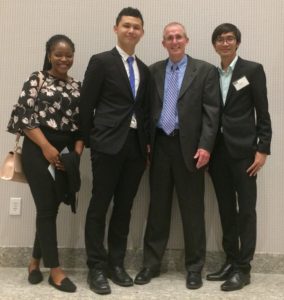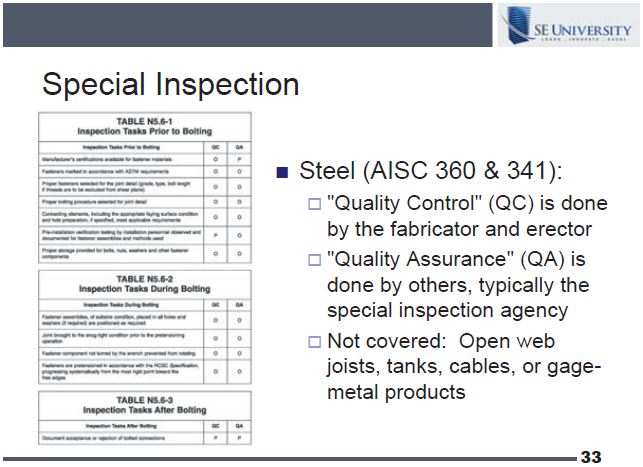29 Oct 2018
Concrete Pryout Failure for Anchors
Anchors in concrete have several different modes of failure when subject to tension or shear loads. Concrete breakouts in tension tend to get the most consideration since the calculations can be more complex depending on various geometric constraints of anchors or anchor groups. For anchor groups in shear, concrete pryout may also be of concern, especially when anchors are short and stocky. At what point does concrete pryout no longer become a design consideration?
In August 2018, Donald Meinheit, PE, SE, from Wiss, Janney, Elstner Associates, Inc., presented Behavior and Design of Anchors in Concrete for SE University. In Part 1 of a two part series, Don covered the different types of anchors, the behavior of anchors in tension and shear, and the various failure modes in tension and shear. Don addressed a question at the end of the session regarding which anchors were prone to concrete pryout failures in shear.
Being familiar with the ratio of the effective embedment depth of the anchor to the diameter of the anchor can help in determining which failure modes will control the design. In normal weight concrete, if this coefficient is greater than 4.5, then concrete pryout in shear is no longer a concern. The short video below features Don addressing the issue of failure due to concrete pryout, and explaining when this failure mode is applicable.
In October 2018, SE University welcomed back Janel Miller, from the University of Wisconsin – Madison, to present Improving Clarity, Coherence, and Conciseness in Technical Writing. Janel designated the Pheasant Branch Conservancy (http://www.pheasantbranch.org/) for the SEU Speaker Inspires donation of the month.
Janel shared why she chose this organization, “The Pheasant Branch Conservancy in Middleton, WI, protects a natural wetland recharged by artesian springs that sustain numerous wildlife and native plants year around. Unfortunately, southwest Wisconsin experienced serious flooding in August, 2018, and several areas of the conservancy were damaged and need to be restored. I am helping with the restoration because natural areas like Pheasant Branch inspire me to remember my role as a steward of our planet and all of its resources.”
Thank you, Janel, for helping structural engineers with your SE University session, and for your designation of the Pheasant Branch Conservancy as our SEU Speaker Inspires Organization of the Month!
SE University began the SEU Speaker Inspires program in 2015 as a way to “pay it forward”, enabling our speakers to designate a charity/organization of their choice for SE University to make a donation to help improve our world.
27 Sep 2018
SE Solutions Provides Scholarships to 3 MSCE Structures Students from Purdue University (2018)
SE Solutions was pleased to recently present scholarships to three Purdue University Structures students to help defray the cost of their education. Yen-Chen Chiang, Farida Mahmud, and Sokheang Thea were the recipients of the awards. This is the seventh year that SE Solutions has offered the scholarships.

Purdue University Students and Scholarship Winners (from left to right) Farida Mahmud, Yen-Chen Chiang, SE Solutions, LLC President, Brian Quinn, Sokheang Thea
Yen-Chen Chiang received his Bachelor’s degree in Civil Engineering at National Taiwan University in 2016, and he anticipates completing his MSCE degree at Purdue University in May 2019. Yen-Chen’s research focuses on finite element analysis of API 650 petroleum tanks, and investigates the stability of such tanks under wind loading. Yen-Chen is interested in facing challenges, and hopes to participate in innovative projects. He is hoping to start his career right after receiving his Master’s degree in a company that has the potential to bring the next most gorgeous structure to the world.
Farida Mahmud is from Lagos, Nigeria. She received her Bachelor of Science in Civil Engineering from University of Arkansas in 2017, and intends to complete her MSCE at Purdue in May 2019. Currently, she is working on research related to the seismic vulnerability assessment of state bridges in Indiana. As a child, Farida was deeply fascinated by bridges and how they worked. This fascination led her to pursue a degree in civil engineering, and eventually structural engineering. Upon graduation from Purdue, Farida would like to find a job in a structural engineering firm here in the United States where she can have the opportunity to work on innovative and challenging projects.
Sokheang Thea is from Cambodia. In 2014, he received his Bachelor of Science in Civil Engineering from Universiti Teknologi Petronas under the sponsorship of Petronas, Malaysia. Upon graduation, he worked in Malaysia for over 3.5 years in a pioneering structural consultant firm. He is a recipient of the Fulbright Scholarship in 2017 to continue his MS degree in civil engineering at Purdue University, and hopes to finish in May 2019. His interest is on the dynamic response of structures, especially tall buildings. Sokheang completed high school in 2008. During that time there were few opportunities for Cambodian students to pursue their interests in science and engineering, since Cambodia was not that developed. He, nevertheless, chose civil engineering as his major and has loved it ever since. Upon graduation from Purdue, Sokheang hopes to join a creative group of similar-minded engineers or firm to provide innovative/efficient solutions to structural problems both in and outside the USA.
SE Solutions would like to congratulate each recipient and wish them future success in their fields of study as structural engineers.
In August 2018, SE University welcomed Donald Meinheit, PhD, PE, SE, from Wiss, Janney, Elstner Associates, Inc., to present Behavior and Design of Anchors in Concrete. Don has chosen to split his donation between Purdue University Lyles School of Civil Engineering Graduate Student Scholarships (https://engineering.purdue.edu/CE), University of Illinois – Urbana-Champaign Civil and Environmental Engineering Trust Fund (https://cee.illinois.edu/give/cee-trust), and the University of Texas at Austin Jack Breen and Phil Ferguson Endowment Funds (http://www.caee.utexas.edu/alumni/gift/opportunites) for the SEU Speaker Inspires donation of the month.
Don shared why he chose these three organizations: “At the time I received my engineering education at Purdue, Illinois, and Texas at Austin, I had no idea of where my professional career would lead me. Fortunate for me, my professors were sincere in their commitment to educate young minds for the future. These three universities nurtured me to become a practical structural engineer with an interest in structural research. It is my desire to support those three institutions to continue teaching young minds.”
Thank you, Don, for helping structural engineers with your SE University session, and for your designation of Purdue University Lyles School of Civil Engineering Graduate Student Scholarships, University of Illinois – Urbana-Champaign CEE Trust Fund, and University of Texas at Austin Jack Breen and Phil Ferguson Endowment Funds, as our SEU Speaker Inspires Organizations of the Month!
SE University began the SEU Speaker Inspires program in 2015 as a way to “pay it forward”, enabling our speakers to designate a charity/organization of their choice for SE University to make a donation to help improve our world.
19 Sep 2018
Ethics in Structural Engineering
How often do you consider your ethical obligations as a structural engineer? What does it even mean to be an ethical engineer? Some might think merely abiding by the laws that apply to everyone else within your jurisdiction is considered ethical, but professional engineers have a duty beyond simply following those laws.
In the April 2018 SE University session, Matthew R. Rechtien, PE, Esq., Senior Assistant City Engineer for the City of Ann Arbor, gave a talk on Engineering Law and Ethics Case Studies. Matt’s presentation helped delineate mandatory versus voluntary rules, and how these guidelines help bolster the status of the engineering profession. As the profession is regulated in all 50 states, engineers have responsibilities and privileges, and are required to uphold certain ethical rules or face possible discipline by the governing and other authorities.
Since laws vary by state, Matt focused mainly on the fundamental principles and canons set forth by ASCE, which he believes are the gold standard and reasonably representative of state laws regulating the profession. Matt also reviewed several case studies with some surprising results based on various ethical dilemmas. These case studies can sometimes initiate thoughtful consideration and create awareness on how to avoid unethical business practices within the profession. You can access additional case studies by visiting http://www.asce.org/ethics/ and you can click here to print your own copy of ASCE’s principles and canons. Also, ASCE offers an Ethics Hotline where engineers can get further guidance on complex issues that may arise by calling 1-800-548-2723 x6151.
Often times, structural engineers may zero in on their responsibility to “hold paramount the safety, health, and welfare” of the public by providing sound engineering judgment, however, their ethical obligation runs much deeper. Being aware of the full extent of your responsibilities and privileges as an esteemed member of this profession can minimize future risk and help promote the status of the profession as a whole.
27 Aug 2018
Input Needed on Proposed Requirements for Thermal Bridges in ANSI/ASHRAE/IES Standard 90.1
On August 22, 1018, Martha Van Geem, PE, Independent Consultant, presented Challenges of Proposed Requirements in ANSI/ASHRAE/IES Standard 90.1 as a supplemental session for SE University. Martha reviewed the proposed requirements being considered by ASHRAE in Addendum av and areas of the country which could be affected by the changes. ASHRAE is seeking input on these proposed changes from practicing engineers, architects, and contractors to substantiate if these requirements are technically sound, practical, and cost effective.
Although structural engineers are not typically the lead designer of the thermal requirements for buildings, the implications of these proposed changes would significantly impact the design community as a whole within many climate zones throughout the United States. Also, the 26 page document is rather complicated and is not constructed in a typical “Code” fashion, but rather requires idyllic, impossible building guidelines followed by a number of exceptions.
In order to ensure these proposed changes are well considered by the design community, ASHRAE is holding a public review until September 17, 2018. Public comments are welcome on the addendum as a whole, specific sections or specific wording. Click here to read Addendum av in its entirety. You can review the instructions for commenting on the Addendum av by clicking here. In order to provide feedback, you will need to create a login on ASHRAE’s website, and click on the Comments next to BSR/ASHRAE/IES Addendum av to ANSI/ASHRAE/IES Standard 90.1-2016, Energy Standard for Buildings Except Low-Rise Residential Buildings (First Public Review Draft). You do not need to be a member of ASHRAE to participate in the public review, and creating a login is free of charge.
As licensed structural engineers, we are often times called upon to serve the public by providing our expertise in order to weigh the importance of safety, constructability, and sustainability of construction means and methods within our industry. Participating in the process may prevent others from dictating the future terms of building construction.
27 Aug 2018
Mentee seeking Mentor
Does your company have a formal mentorship program? While some larger engineering firms have made efforts to form employee development programs, not all firms have a formal program in place to guide young or even experienced engineers toward needed growth and improvement. If your company does not offer a mentorship program, make it your goal to seek out your own mentor!
Typically, mentorship programs are most successful when they are driven by the mentee’s desire to self-improve. Since you are your own best advocate, there is no reason why you can’t acquire your own mentor, even if one is not provided by your company. This may even work to your advantage, since you will have complete control over who you consider as a possible mentor.
First, consider those within your organization who may be a step ahead of you in the hierarchy of your company. While it may be tempting to shoot for someone at the top, your mentor should serve as a stepping stone to boost you to the next level of success. If your company is very small, and there are not many degrees of separation between the top and bottom, you may need to search outside your company. Often times, professional organizations such as SEI, NCSEA or ASCE offer many opportunities to volunteer for committees where you may meet engineers who could be suitable candidates.
Once you’ve found a potential mentor, simply ask if he/she has the availability to meet with you occasionally to answer questions, gain insight into their daily tasks, and guide you on ways to improve your skills. Asking another engineer for help, may seem uncomfortable, however, showing an initiative to improve one’s skills is always applauded. Experienced engineers may not offer unsolicited advice to avoid sounding bossy or self-important, but when asked, their knowledge and past mistakes can be great learning tools for you.
A successful career in engineering takes time and energy to seek out the positive influences and guidance of knowledgeable colleagues who encourage our curiosity. Without such mentors, success can seem elusive and distant. Take the initiative, and find your own mentor… it might just launch you into the next phase of your career!
23 Aug 2018
Statement of Special Inspections
For certain structural projects, special inspections are required by the code to ensure a high quality of construction. However, which elements require special inspections? How often are the inspections required and who is responsible for ensuring the are completed at the appropriate time during construction.
In the July 2018 SE University session, Dave K. Adams, SE, from BWE, presented Project Quality and Inspection Requirements. Dave reviewed the building department’s role in project quality standards, identified specifications for durable materials, and covered the requirements for structural observations and special inspections. Dave addressed many of the pitfalls associated with special inspections and how to ensure these inspections are well understood by all responsible parties prior to construction.
Dave noted the importance of including the Statement of Special Inspections which can be included in the form of notes in the project drawings or as a separate set of forms. As outlined in Chapter 17 of the IBC, the statement of special inspections should include the type of work requiring inspections or tests, and whether it is to be periodic or continuous. Often times, the permitting agency will allow the inclusion of reference table from relevant codes on the drawings to clearly delineate which tasks are required. Dave included as an example, the following slide which specifies the requirements for special inspection of bolted connections, which can be included on the drawings or at the very least referenced to make clear which tasks are expected.
The contractor should be in communication with the authorized agent to ensure inspections are done at the appropriate stage of construction and documentation should be provided to all involved parties. Communication is key to be sure expectations are met in accordance with the code. For further requirements for special inspections, see IBC section 1704 and 1705.
20 Jul 2018
Structural Observation vs. Special Inspection
What is the difference between structural observations and special inspections? At times engineers use these terms interchangeably, but there are specific instances where structural observations are appropriate, or more detailed special inspections may need to be specified.
In July 2018 SE University session, Dave K. Adams, SE, from BWE, presented Project Quality and Inspection Requirements. Dave reviewed the building department’s role in project quality standards, identified specifications for durable materials, and covered the requirements for structural observations and special inspections. He specifically addressed the difference between the two terms in a follow up question at the end of the session. Watch this short video to hear Dave’s explanation.
Structural observations and special inspections are required by the code and can be found in IBC 2015 Sections 1704.6 and 1704.2, respectively, and depend on the building’s design category, the risk category and design wind speed. Observations or inspections should be delineated clearly before construction to include the requirements, responsible parties, and frequency to ensure the building is code compliant.
16 Jul 2018
“SEU Speaker Inspires” Organization of the Month: UCSD Undergraduate Student Scholarships Fund
In July 2018, SE University welcomed back Dave Adams, SE, from BWE, to present Project Quality and Inspection Requirements. In 2016, he designated the University of California at San Diego Undergraduate Student Scholarships Fund (https://giveto.ucsd.edu/) for the SEU Speaker Inspires donation of the month, and he has chosen to do the same in 2018.
Dave chose UCSD Undergraduate Student Scholarships Fund for his SEU Speaker Inspires donation because he would like to help make it possible for more students to attend UCSD and study structural engineering.
Thank you, Dave, for helping structural engineers with your SE University session, and for your designation of the University of California at San Diego Undergraduate Student Scholarships Fund as our SEU Speaker Inspires Organization of the Month!
SE University began the SEU Speaker Inspires program in 2015 as a way to “pay it forward”, enabling our speakers to designate a charity/organization of their choice for SE University to make a donation to help improve our world.





